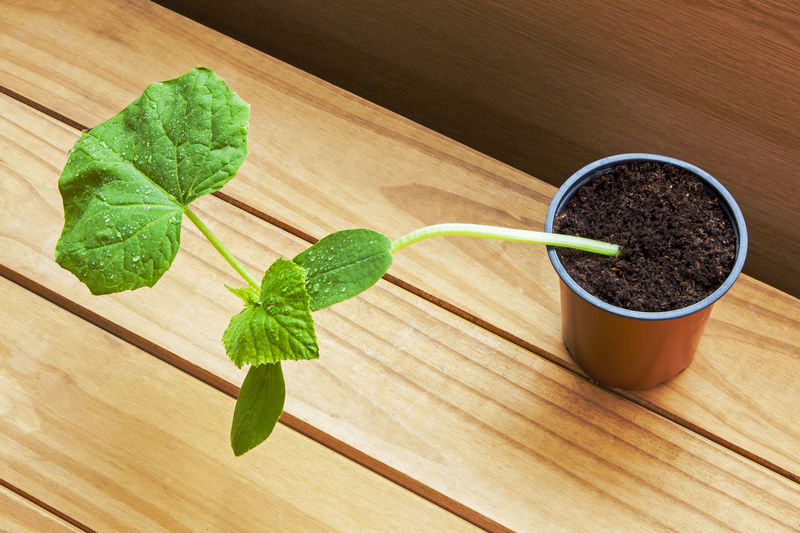Garden Survival Tactics in Extreme Weather
Posted on 30/08/2025
Garden Survival Tactics in Extreme Weather: Protecting Your Plants Year Round
Whether you're a dedicated vegetable grower or a flower enthusiast, extreme weather patterns can seriously challenge your gardening success. More gardeners are searching for garden survival tactics in extreme weather as unpredictable conditions like heat waves, cold snaps, droughts, and torrential storms become more frequent. This comprehensive guide delves into the best practices, tools, and strategies for defending your garden against the worst that nature can throw at it.

Understanding the Impact of Extreme Weather on Gardens
Extreme weather includes events such as intense heat, deep freezes, excessive rainfall, strong winds, and prolonged droughts. These climate extremes can:
- Cause soil erosion and nutrient depletion
- Trigger plant stress, stunted growth, or even sudden death
- Spread disease and pests as plants become weakened
- Destroy hard-earned yields through flooding or hail
Adapting your approach with survival gardening techniques can help ensure that your garden thrives, no matter the forecast.
Assess Your Garden's Vulnerabilities
Before applying solutions, first evaluate which threats your particular garden faces. Some areas are more susceptible to wind storms, while others might face regular flooding or drought conditions. Take into account:
- Your USDA Hardiness Zone
- Soil type and drainage
- Surrounding topography
- Microclimates within your property
- Past weather events and patterns
Proactive planning rooted in these details gives your garden the best chance of survival when the unexpected happens.
Garden Survival Tips for Heatwaves
1. Mulch Heavily
Mulching is one of the most effective garden survival tactics in extreme heat. A thick, organic mulch layer (such as straw, woodchips, or bark) shields soil from direct sunlight, reduces water evaporation, and keeps root zones cool. Aim for 3-4 inches and replace mulch as it breaks down.
2. Water Wisely
- Water in the early morning or late evening to reduce evaporation.
- Deep soak plants less frequently rather than giving shallow water daily.
- Consider drip irrigation or soaker hoses for efficiency.
3. Provide Shade
During extreme heat, even sun-loving plants appreciate some midday shade. Use:
- Shade cloth with 30-50% light filtration
- Temporary shelters (old sheets or umbrellas)
- Strategically plant taller crops to shield shorter, more sensitive ones
4. Choose Heat-Tolerant Varieties
Select cultivars specifically bred to withstand high temperatures and drought. Many modern vegetables and ornamentals list heat tolerance on their seed packets.
Garden Survival Advice for Droughts
Drought conditions can persist for weeks or even months, putting immense pressure on your plants and water resources.
1. Build Resilient Soil
- Incorporate compost and organic matter to boost moisture retention
- Practice no-till or minimal tilling to preserve soil structure
A healthy, living soil acts as a reservoir, delivering consistent moisture to plant roots and reducing your irrigation needs.
2. Prioritize Watering
- Focus first on your most valuable and vulnerable crops
- Group plants with similar water requirements together (a concept called hydrozoning)
3. Harvest Rainwater
Install rain barrels, cisterns, or even simple buckets to collect and store storm runoff for times of need. This is a classic garden survival strategy that also conserves resources.
4. Grow Drought-Resistant Plants
- Lavender, sage, rosemary, and many native wildflowers tolerate dry soils
- Succulents, sedums, and ornamental grasses require less water once established
5. Reduce Plant Density
More space between plants cuts competition for limited water, helping each one survive during a drought crisis.
Protection from Heavy Rain & Flooding
1. Improve Drainage
- Build raised beds to elevate root systems above saturated ground
- Loosen soil and amend with sand/compost for better porosity
- Install French drains or swales to direct water away from priority garden areas
2. Rain Covers and Tunnels
Lightweight tunnels (row covers) or plastic cloches can shield vulnerable crops from excess rain and hail. For larger spaces, temporary poly tunnels or lean-to structures protect not just from water, but also windblown debris.
3. Secure Loose Items
Before a storm, fasten down trellises, planters, and garden decor to prevent damage to plants and property from flying objects.
Gardening in Extreme Cold and Frosts
Unexpected frosts and severe cold can devastate delicate annuals and damage even hardy perennials.
1. Insulate with Mulch and Row Covers
- Build up mulch around the base of plants to insulate roots
- Cloches, cold frames, or row covers trap heat to protect foliage from frost
2. Use Windbreaks
Rows of shrubs, fences, or even straw bales as temporary structures can cut down relentless wind that chills plants and dries out soil in winter.
3. Select Cold-Tolerant Plants
- Look for cultivars bred for cold climates
- Plant perennials that go dormant in winter and return each spring
Mitigating Wind Damage
High winds can shear branches, uproot new plantings, and strip moisture from leaves and soil. Here are powerful garden survival tactics for windy weather:
- Stake or cage vulnerable plants, such as tomatoes and young trees
- Establish living windbreaks: Hedges, rows of evergreens, or bamboo screens protect both plants and topsoil
- Choose flexible, wind-resistant species for exposed areas
- Keep trees pruned to remove damaged limbs and reduce wind resistance
Year-Round Preparedness: Building a Resilient Garden
Garden survival tactics in extreme weather are more effective when you have a plan set before disaster strikes. Here's how to cultivate year-round resilience:
1. Diversify Your Plantings
A diverse garden is naturally more resilient. If one species struggles, others may still thrive. Mix annuals and perennials, shallow and deep-rooted plants, and include natives accustomed to your local conditions.
2. Maintain Garden Records
Document each season's weather events, plant performances, and your interventions. These notes help fine-tune future survival tactics and reveal the most reliable crops for your microclimate.
3. Invest in Smart Tools and Technologies
- Moisture meters take the guesswork out of watering during drought
- Weather apps and smart garden sensors help predict when to protect or irrigate
- Self-watering containers and drip irrigation increase efficiency
4. Foster Healthy Soil
Vital soil is a garden's first defense against extreme weather. Regularly add compost, mulch, or green manures. Avoid over-fertilizing, which can make plants prone to weather shock.
Best Practices for Emergency Response
If an extreme event is imminent, take swift action:
- Harvest ripe crops early before storms or freezes hit
- Move potted plants to sheltered locations
- Cover sensitive beds with frost blankets or tarps
- Stake plants prone to wind damage, and remove weak branches from trees
Adapting to Climate Change with Garden Survival Techniques
Climate change is intensifying weather unpredictability. Adopting garden survival tactics for extreme weather is vital for long-term success. Here's how modern gardeners are adapting:
- Xeriscaping: Designing landscapes to minimize water use
- Permaculture principles: Creating self-sustaining ecosystems that mimic nature
- Using local, climate-adapted seeds and plants
- Collaborating with community gardens for shared resources and knowledge
It's also essential for gardeners to embrace flexibility--being ready to experiment, fail, and learn what works for your unique plot.

Essential Garden Survival Checklist
- Mulch supply for insulation and moisture control
- Compost and soil amendments
- Reliable water source or storage (rain barrels, cisterns)
- Row covers, cloches, or frost blankets
- Stakes and trellises
- Shade cloth and windbreak materials
- Emergency repair supplies (tarps, ties, stakes)
- Seed stash with heat and drought-tolerant varieties
Conclusion: Gardening for the Future
With rising global temperatures and increased storm frequency, garden survival in extreme weather is more important than ever. By understanding your challenges, planning ahead, and adapting creative tactics, you'll not only safeguard your plants but also ensure bountiful harvests for seasons to come. Each challenge, no matter how daunting, holds lessons and opportunities for growth--with the right strategies, your resilience will bloom alongside your garden.
Remember: The best gardens don't just survive--they adapt and thrive, no matter what the weather brings.

